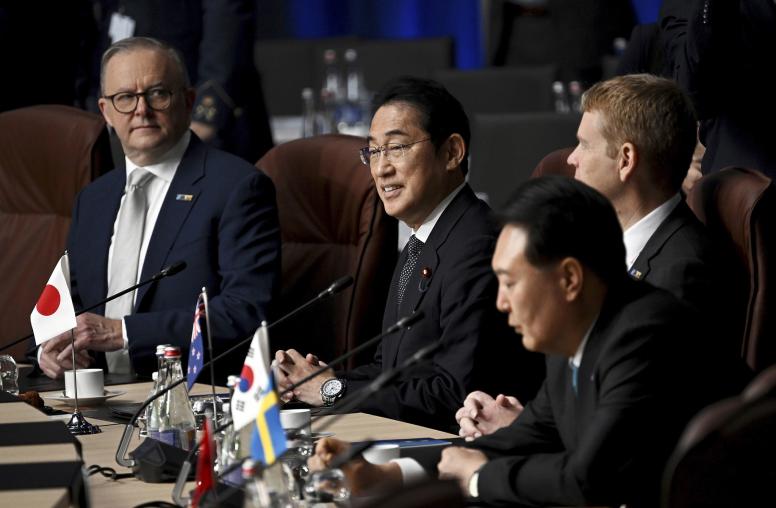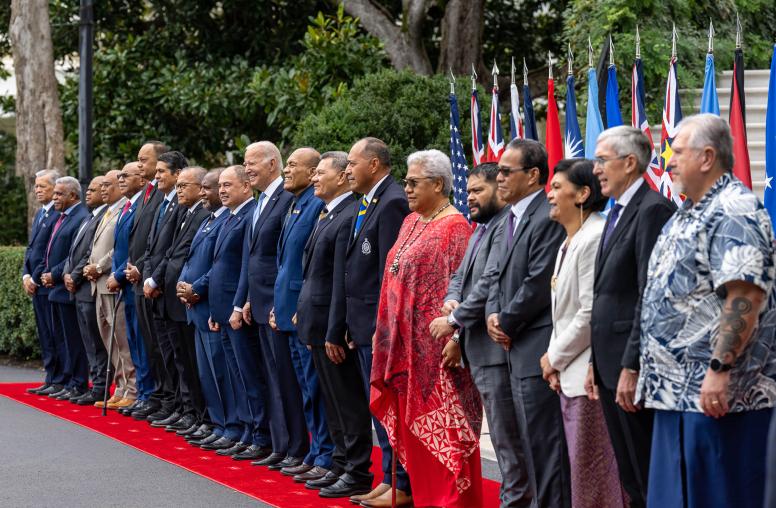What Is Indigenous Foreign Policy? Lessons from Australia and New Zealand
A new pillar of Australian foreign policy may have implications for the Pacific Islands region and the United States.
In early May, the Solomon Islands — the second largest recipient of Australian aid — signed a security agreement with China, raising concerns about the potential for the creation of a Chinese military base a short distance from Australia’s shores. Coming mere weeks before Australian elections, this announcement was widely seen by Australians as a failure of their foreign policy and helped turn national security into a high priority for the elections.

Amid the backlash, the Labor party announced that if elected, it would deliver a First Nations foreign policy and appoint an ambassador for First Nations peoples. Promising to “weave the voices and practices of First Nations peoples into the way [Australia] talks to the world” and “use all elements of Australian power” to engage with its “Pacific family,” the announcement demonstrates an intent to strengthen relationships with Australia’s neighbors by capitalizing on a nascent movement in western settler-colonial states to “indigenize” their foreign policy, most notably undertaken by Aotearoa New Zealand.
On May 21, Australia elected a new government, ending a nine-year incumbency for the Liberal-National Coalition and ushering the Labor Party into leadership. In her fourth day on the job, newly minted Foreign Minister Penny Wong traveled to Fiji, where she gave a speech that reiterated the new government’s commitment to a First Nations approach to foreign policy. Given the close coordination between the United States and its allies and partners in the Pacific Islands region, it is important for the United States to understand the implications of these changes to Australia’s foreign policy approach as the United States seeks to strengthen its engagement in the region.
Defining Indigenous Foreign Policy
At the outset, defining Indigenous foreign policy requires tremendous deliberation and caution. While there is great potential to create a shared community in which Indigenous peoples are afforded equitable power and mutual respect, there is also great risk of unintentionally perpetuating colonial exploitation.
Indigenous foreign policies are sometimes framed as a means of leveraging the diplomatic capacities of Indigenous peoples, which were cultivated over thousands of years prior to European settlement as communities negotiated sovereign relationships through both violence and treaty. In this framing, Indigenous peoples are seen as a valuable resource that can contribute to and strengthen the state’s overall collective authority and power.
However, such approaches use the language of indigeneity without embodying it — for example, by purporting to elevate Indigenous voices without engaging in respectful consultation to develop shared policy priorities. This framing of Indigenous foreign policy acknowledges the agency and capacity of Indigenous peoples while co-opting and subjugating it to that of the state.
A truly Indigenous foreign policy would be rooted in mutual respect for — and recognition of — the agency of Indigenous peoples as sovereign nations with whom the state is in a shared political community. Sharing a political community requires the state to respect Indigenous constitutional orders (i.e. their means of constituting political communities) and that those constitutional orders inform the shape and structure of the shared political community rather than being twisted, bent and broken to conform to standards set by the state. In other words, a state cannot have an Indigenous foreign policy unless it has established a means for constituting a shared political community with its Indigenous peoples within the territory of the state.
Assuming these conditions are met, the specific content of a country’s Indigenous foreign policy would then be informed and defined by an ongoing negotiation between the state and Indigenous peoples, and therefore the results would be as diverse as the numerous Indigenous peoples across the globe.
However, at the risk of oversimplifying and promoting pan-indigeneity, there are common features among Indigenous peoples whose worldview and constitutional order embody and replicate the order of the natural world — like those in Australia or New Zealand — that might be reflected in an Indigenous foreign policy, such as: an ontology of interdependence, ongoing relationships whose responsibilities change based on circumstances and needs, and co-creation.
Comparing Australia’s and New Zealand’s Approach to Indigenous Foreign Policy
Aotearoa New Zealand — though not perfect — acknowledges that its engagement with peoples outside of its borders is inextricably linked to how it engages with Māori peoples within them. Recently, the government has taken steps to reconcile and improve its relationship with Māori peoples, which was first established by the Treaty of Waitangi in 1840.
In 2018, the New Zealand Cabinet established Te Arawhiti, or the “Office for Māori Crown Relations,” dedicated to improving the relationship between government agencies and Māori peoples. During extensive consultations with the former minister of justice, Māori stakeholders across the country identified several key problems in government-Māori relations, including a lack of a common understanding about New Zealand’s history, the government’s lack of knowledge and capacity to engage meaningfully with Māori peoples, and crucially, the meaning of the Treaty of Waitangi.
Māori understand “treaty” to mean a relationship based in interconnectedness and mutual respect — and requires reciprocity. Te Arawhiti was created to facilitate that reciprocal relationship across the New Zealand government. This Māori understanding of treaty, which is embedded in Māori worldviews, now informs not only New Zealand’s relationship with Māori peoples internally, but also its foreign policy. In other words, New Zealand makes a deliberate effort to afford Māori peoples the respect and agency to shape the state’s political community in a process approaching co-creation.
By contrast, Australia very arguably does not have a shared political community with its Indigenous peoples. Unlike New Zealand — and most parts of Canada and the United States — Australia does not have a treaty with the Indigenous peoples on the continent. In other words, there is no shared understanding that serves as the basis for establishing and maintaining the relationship.
In 2017, a constitutional convention attended by 250 Aboriginal and Torres Strait Islander delegates issued the Uluru Statement from the Heart, a consensus position on Indigenous constitutional recognition in Australia. The statement calls for constitutional reforms to empower Indigenous peoples, enshrine a First Nations Voice in the Australian Constitution, and establish a Makarrata Commission to supervise agreement-making between Australian governments and First Nations.
In her recent speech in Fiji, Foreign Minister Wong stated, ambitiously, that the new government “is committed to implementing the Uluru Statement in full.” This reconciliation between First Nations and the Australian government is a vital precondition to the development of an indigenous foreign policy.
But at the same time, Australia uses the language of indigeneity in its foreign policy by, for example, referring to its Pacific neighbors as “family,” which was featured in Wong’s speech. This invokes the importance of kinship to building and maintaining Indigenous political community. Yet the application of kinship terms in relationships between Indigenous and settler peoples is fraught with heavy colonial baggage.
In 2021, the Australian Department of Foreign Affairs and Trade released its Indigenous Diplomacy Agenda to “elevate Indigenous issues in the work of the foreign affairs and trade portfolio.” However, it espouses a vision with objectives that ignore and subjugate — rather than acknowledge and respect — the sovereign agency of Indigenous peoples, casting them as victims in need of support rather than inviting them to participate in the co-creation of foreign policy. Similarly, in Wong’s speech, she continued to frame the development of a First Nations foreign policy as an opportunity to leverage the power of Indigenous peoples for the Australian state, rather than including them as partners in its co-creation.
Lessons for the U.S. in the Pacific Islands
As the United States looks to enhance its engagement in the Pacific Islands, in close coordination with Australia and New Zealand, it should have an interest in how these two key partners implement an Indigenous foreign policy.
While the Australian Labor Party’s intentions signal a positive shift, there exists an enormous amount of domestic work to actualize a foreign policy approach that envisions deepened ties with the rest of the Pacific. By comparison, Aotearoa New Zealand’s approach is one to emulate due to its resonance with Indigenous populations in the Pacific Islands and the domestic integrity underlying it.
As U.S. policymakers consider methods of deepening U.S. ties to the Pacific, the idea of borrowing from the journey that New Zealand and Australia have undertaken will naturally emerge. The United States is similarly founded on indigenous land and has ongoing treaty relationships with indigenous peoples across the continent, including in the Pacific. One U.S. state (Hawai’i) and three populated territories (Guam, the Commonwealth of the Northern Marianas Islands, and American Samoa) are constituent parts of the Pacific Islands region with Indigenous populations.
Though Aotearoa New Zealand provides a positive model for foreign policy engagement, the need for internal reconciliation might hinder U.S. capacity to employ such an approach. However, there are certain principles and practices the United States should adopt in its engagement with Pacific Islands nations, namely recognition of the importance of these nations to U.S. security through diplomatic attention and development resources, a responsiveness to Pacific Islanders’ needs — particularly as they relate to climate change — and consistency in engagement.



